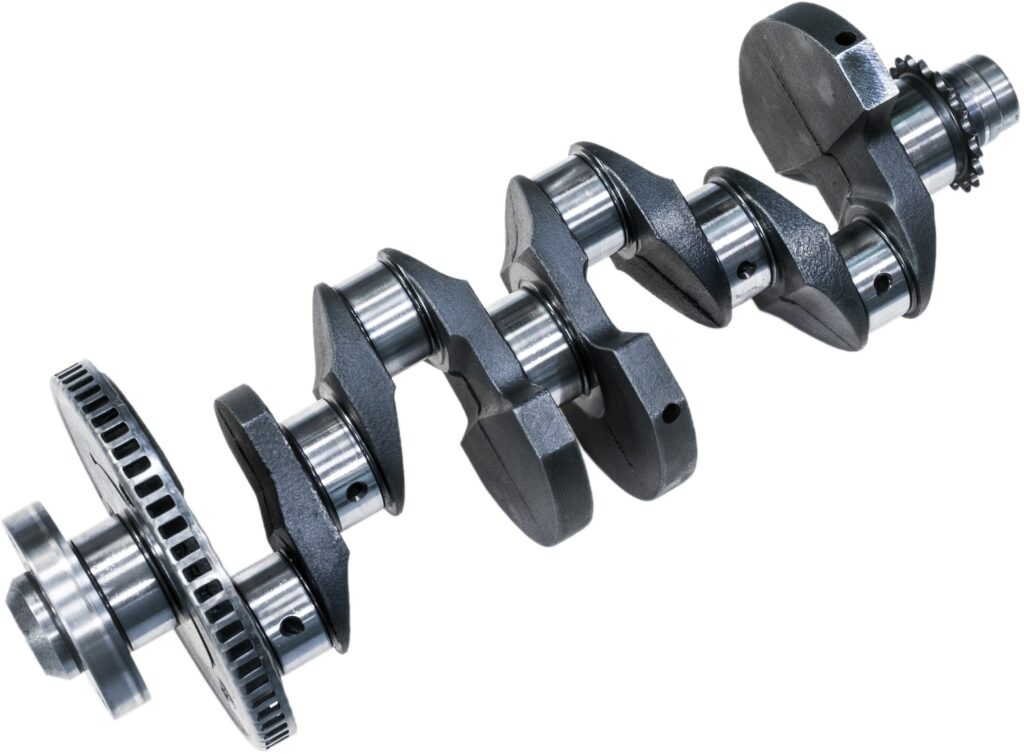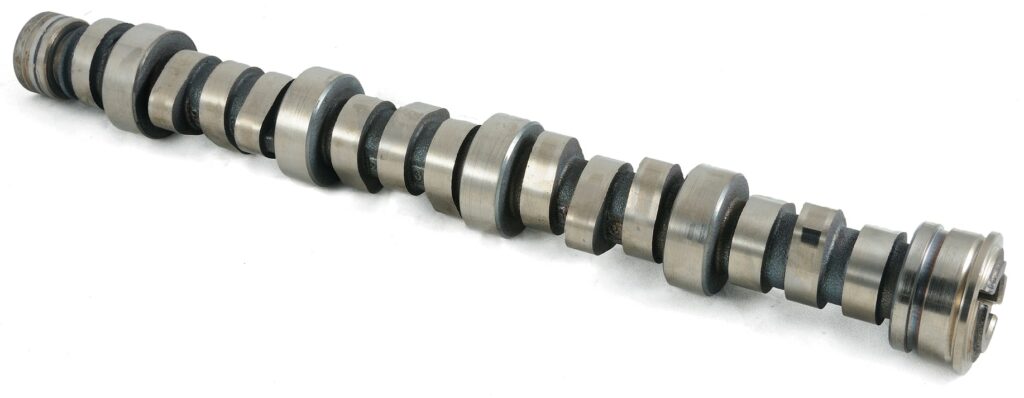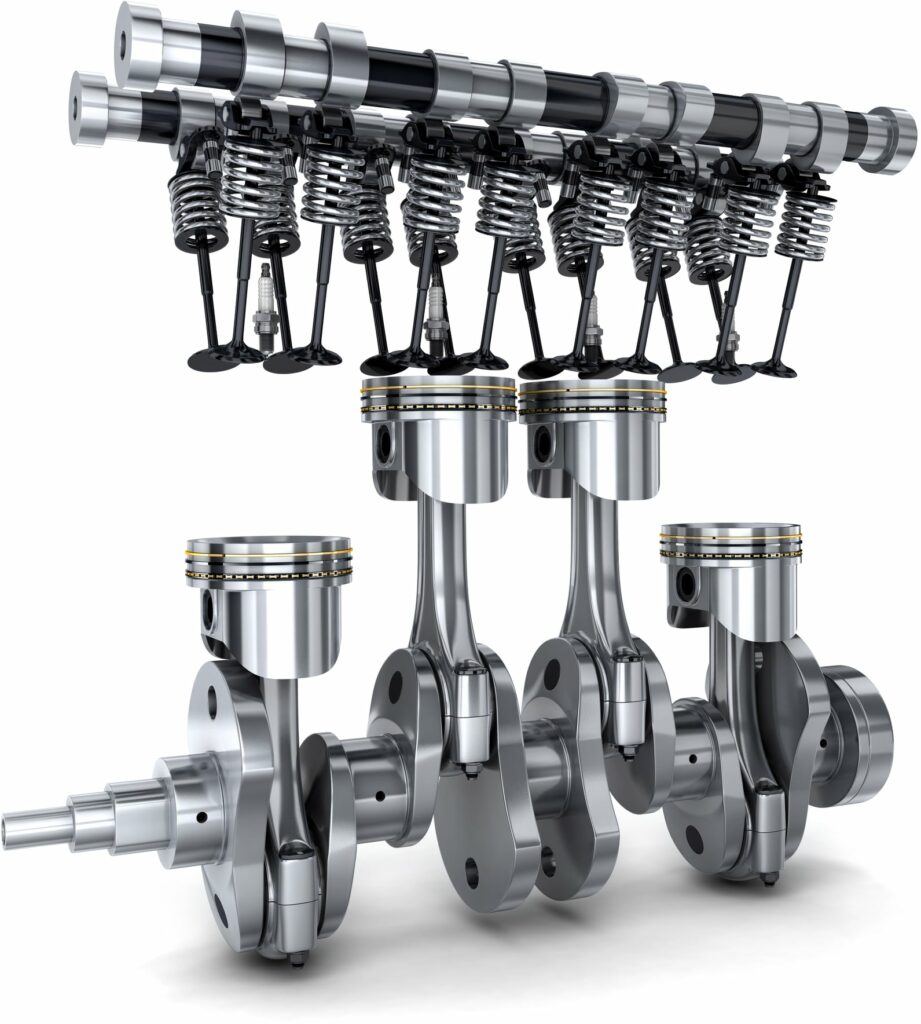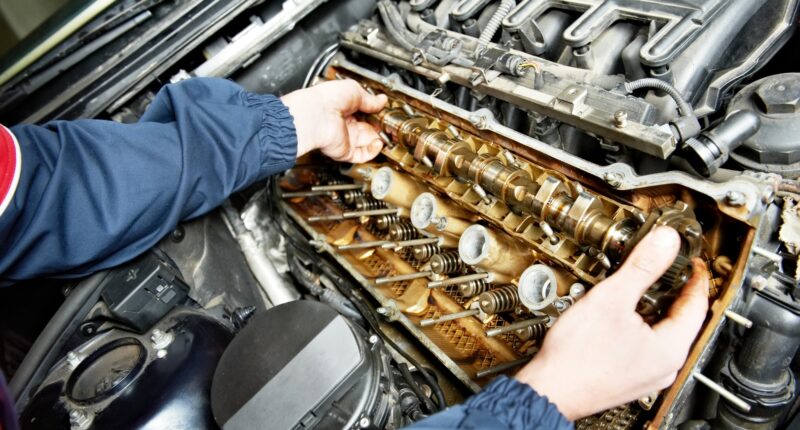Camshafts and crankshafts are terms you’ve probably heard if you’ve discussed internal combustion engines with your mechanic (or fellow car enthusiasts). But what is a camshaft or a crankshaft, and what do they do?
While it might seem a little complicated at first, it’s not nearly as daunting when you break everything down.
In this guide, we’ll explore everything you need to know about camshafts and crankshafts — from what they are to how they work.
What Is a Crankshaft?
The crankshaft is one of the most significant components of your engine.
Crankshafts turn linear power from the pistons into rotational power that the transmission can deliver to the wheels. It also uses all that rotational power to activate your car’s accessories, making it one of the most diverse power distribution systems in your car.
In simple words, your crankshaft delivers the power that your pistons create. Your engine uses this power to drive the serpentine belt (or chain) that is attached to the front of your engine, and this belt drives all of your accessories.

From your A/C to your alternator, the belt drives it all. Of course, your crankshaft also drives your engine’s propeller shaft — which is what delivers power to the wheels through your transmission.
If the pistons are the workhorses — the crankshaft is the delivery service.
How a Crankshaft Works
Your crankshaft is one of the bulkiest components on your engine. It’s also one of its simplest. It’s this mechanical ingenuity that makes the crankshaft a modern mechanical marvel.
The crankshaft has several main components that make it work.
First are the offset shafts (also known as the connecting rod journals) where the connecting rods meet. These rods are connected directly to the piston, and as the crankshaft spins, it pushes these connecting rod journals up and down, moving the pistons in the process.
Furthermore, the crankshaft has a gear attached to the front end, and this gear attaches to the serpentine belt, which drives all of your engine’s accessories.
Another feature in the crankshaft are it’s counterweights. The pistons moving up and down create a lot of force that would otherwise move your engine all over the place.
While engine mounts bolt your engine down, another thing keeping your engine from moving too much and keeping everything balanced is the crankshaft’s counterweights.
They are simply heavier parts of the crankshaft that the manufacturer strategically placed to keep everything balanced as the crankshaft spins at insanely high RPMs. Modern engines use crankshaft position sensors to keep timing absolutely perfect.
What Is a Camshaft?
Before you can break down how they work (and answer the question what do cams do?), you need to first understand what a camshaft is!

The simplest way to define a camshaft’s function is that it turns rotational motion into reciprocal motion. Sounds confusing? Let’s break it down.
The crankshaft spins and this spinning turns the timing belt or chain, which rotates your camshaft. This is your rotational motion.
Your camshaft takes all this rotational motion and uses it to repeatedly raise and lower your engine’s intake and exhaust valves. This timing needs to be exact; if your intake valve doesn’t open when it needs to, there won’t be any air to facilitate ignition.
If the exhaust valve doesn’t open on time, all the burnt fuel and air have nowhere to go — making it difficult for new air to enter the system. Modern engines also use camshaft position sensors to get the absolute best performance while maximizing fuel efficiency.
It might not seem like much, but your camshaft is one of the most critical aspects of your engine. If you’re looking for serious performance upgrades, a camshaft upgrade and a tune are a surefire way to get there.
How Does a Cam Work?
Just like the crankshaft, the camshaft is a relatively simple concept to understand. But what do cams do, and more importantly, what does a cam do for performance?
The camshaft is a metal rod with offset lobes attached. These offset lobes rest against pushrods, which are attached to rocker arms.
As the larger part of the lobe pushes against the pushrod, it raises it. The other end of the rod pushes against the rocker arm, which in turn raises or lowers the corresponding valve.
When the lower part of the lobe comes back around, the pushrod lowers back down, and the cycle repeats.
Since the camshaft is attached to the crankshaft via the timing belt, it doesn’t matter how fast or slow the engine goes; the camshaft always stays in perfect rhythm.
This is essential to keep everything operating smoothly and tweaking this time would be detrimental to engine performance.
Performance Camshafts
If you think that there isn’t much of a difference between different camshafts since they all have to be in a 1:2 ratio with the crankshaft — stop right there.
Performance camshafts differ from regular units, and it all comes down to timing.
The longer the intake valves are open, the more time you have to force air into the combustion chamber. The more air you get in there, the more force you can generate with each explosion.
That’s why performance units have bigger lobes compared to stock cams. However, you must tune your engine if you’re replacing your camshaft. Failure to do so will result in you destroying your engine, typically within minutes of starting it.
So, what does a performance camshaft do? It completely overhauls your engine and optimizes performance.
Dual Overhead Cams (DOHC) vs Traditional Camshafts
One of the features you’ll hear manufacturers bragging about is dual overhead cams or DOHC. The most significant advantage to a DOHC is that you get two intakes and two exhaust valves per cylinder.

This allows the engines to operate at higher RPMs while still getting the necessary air that they need to operate. While this is the most prominent advantage to systems with two camshafts compared to one, there are overhead systems with only one camshaft as well.
Both systems eliminate the pushrods entirely, and instead, the rocker arms are positioned directly against the camshaft. This provides a few advantages in itself, and it allows the manufacturer to place the sparkplug in the middle of the combustion chamber for increased efficiency.
Both DOHC and single overhead cam (SOHC) systems operate with the same principles, but engines with DOHC are typically higher performance engines.

The only real drawback to DOHC compared to SOHC is that DOHC systems are slightly less fuel-efficient and a little more expensive to repair. However, if your camshaft needs repair, it’s not going to be cheap, no matter the system your vehicle has.
In fact, if your camshaft needs repair, there is a high probability that multiple other components are damaged, and you might need a new engine.
The Real Difference Between Camshaft vs Crankshaft
One of the most significant differences between the two is their shape. Camshafts are long and narrow, with offset lobes throughout.
Crankshafts, on the other hand, are large and bulky. While mostly round in nature, they have offset mounting areas for the connecting rod which makes them stocky and cumbersome to work with.
Of course, it’s not just about how the two look, these are two entirely different components that serve completely different functions. Breaking down the purpose behind a crankshaft and camshaft is just as essential.

While the crankshaft is a power delivery tool, the camshaft is the rhythm that keeps everything working when it should. They are both critical to engine performance, but they are entirely different components.
How They Work Together: An Amazing Choreography
While there are tons of things to break down when comparing these two engine components, there is an interesting ratio that keeps everything running smoothly.
The timing chain (or belt) connects the crankshaft to the camshaft, and the camshaft will always turn in a 1:2 ratio with the crankshaft.
When you break it down, it makes perfect sense. Four-stroke engines have four stages where valves open and close— intake during one stage, to such in air, and exhaust in another to get rid of exhaust gases. During the final two stages, both valves remain closed.
But for every turn of the camshaft, you open and close both the intake and exhaust valve once. By staying at half the speed of the crankshaft, everything stays in perfect timing.
Too fast or too slow and this timing would be thrown completely off, and your vehicle would never make it out of the driveway.
FAQs
What Is the Speed of a Camshaft in Relation to a Crankshaft?
A camshaft on a four stroke engine runs at half the speed of the crankshaft—the intake and exhaust valves open one time (each) for every two engine revolutions. That is, 1:2.
In a two stroke engine, the ratio is 1:1. For every crankshaft revolution, the camshaft does the same.
How Is a Camshaft Connected to a Crankshaft?
There are 3 methods that connect a camshaft to a crankshaft, but they all do the same thing—ensuring the timing between the two components is correct. These 3 different timing components are:
- timing chain,
- timing belt (also known as serpentine belt, when they drive more than just these 3 shafts), and
- a mesh gear set.
What Drives the Camshaft?
Camshafts are driven by the crankshaft by way of one of a timing chain, toothed rubber belt, or timing gears.
The More You Know
Whether you were just looking for a better answer to the oft-asked question of what these engine parts are, or you’re trying to get a better understanding of how the magical machine in your driveway works — understanding the differences between a camshaft and a crankshaft is vital.
They both serve unique and critical functions for your engine, and while novices often confuse the two, there’s not much that the two parts share.
Now that you’ve got a solid grasp on the mechanical basics, take a look at some of our other guides that cover common car components in detail.
Like what you’ve read here or have questions? Leave a comment below, we’d love to hear from you!


3 comments
This was very helpful and detailed ????
Thank you ????
Excellent explanation and the videos were extremely helpful for a novice like myself.
My ex left behind a 1972 Fiat Spyder convertible which has been garage kept since the mid 80s when it stopped running abruptly and the mechanic told him it needed a new (camshaft or crankshaft), which had to be either imported from Italy or fabricated. I am trying to get the car out of my garage. But I can’t remember which part it needs. So I don’t know what to tell potential buyers. Is there a way for me to figure it out by from what I remember about when it broke down or by looking at the engine? How much difference will it make to a buyer which part it needs? Thank you for any help you can give me.